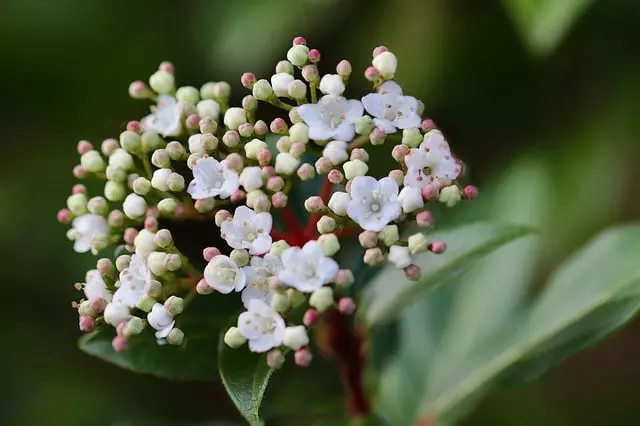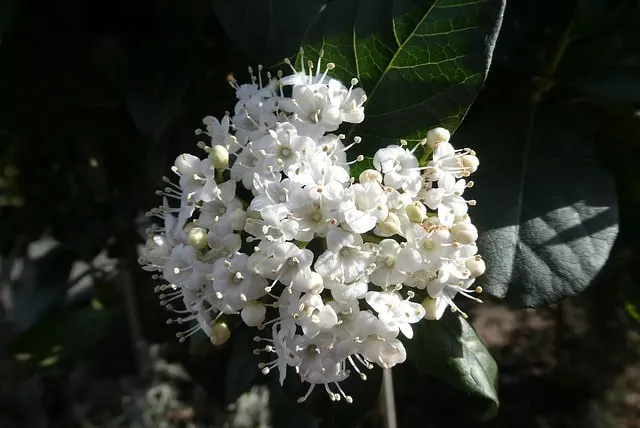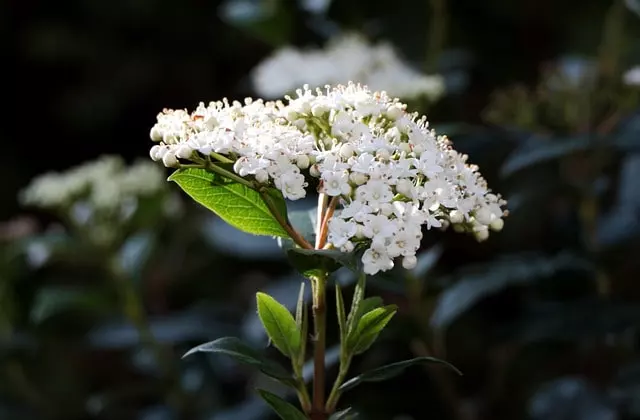Viburnum tinus is a plant that can be found naturally in the Mediterranean area. It is a very hardy shrub, which thanks to its hardiness is suitable for cultivation by beginners and plant enthusiasts without much time. But what is it about this plant that makes you want to incorporate it into your home or garden?
Nothing less than a beautiful bloom of white bouquets, which you can enjoy during the winter, that time of the year when so few plants can show their best face. If you want to learn how to grow Viburnum tinus at home, keep reading this article.
Table of Contents
Characteristics of Viburnum tinus
Commonly called laurustinus, laurustine, or laurestine, the Viburnum tinus is a shrub of great hardiness that, in its natural environment, can reach heights of up to 10 ft (3 meters), being possible to cultivate it to look like a tree.
It is an evergreen plant, being oval and leathery, bright green, and with the underside covered with a layer of fine hairs. Its flowering occurs in late winter and lasts until spring, with flowers that emerge from small pink buds and open in showy bouquets of up to 4” (10 cm). Its fruits with small berries or dark blue spheres are showy and beautiful too.
It is commonly used in gardens for spaces in the form of hedges or simply as shrubs or small trees. Its great resistance allows it to grow even in coastal environments, withstanding the sea breeze.

Location for Viburnum tinus
Viburnum tinus can be grown either in full sun or semi-shade, depending on the space you can give it. However, what this plant does not adapt well to is indoors: find a corner in your garden, where it will grow without problems as long as it has some light.
Of course, if you give it a full sun exposure, the plant will be much less likely to be attacked by fungi, so if you can afford it, give it light. Otherwise, it will be enough to check it in periods of mild temperatures and high humidity, treating it with homemade and ecological methods if necessary.
As for temperature, Viburnum tinus can withstand occasional frosts as long as they are brief, but prolonged frosts can cause severe damage.
Watering Viburnum tinus
Like most Mediterranean climate plants, this shrub tolerates drought quite well, which means that, when in doubt, it is better to under-water than over-water.
- During warm months: water when the soil is dry below the surface.
- During cold months: it will be rare that you will need to water your laurustinus.
Only if the leaves show signs of drying out too much will you need to add some water on a bi-weekly or monthly basis. Never puddle the soil when watering, as we always recommend. This will cause root rot in almost any plant and damage that is difficult to repair. Learn more about the best time to water plants.

Soil for Laurustinus
The most important thing (and practically the only thing too) is to find an area with well-drained soil. Clay soils tend to become waterlogged, so laurustinus is not very friendly to them. Water in your garden before planting and look for an area where water will not pool or puddle. If it drains well and quickly, it will be a good spot.
If you don’t have adequate soil, you can always remove a good area slightly larger than your shrub and prepare a mixture with sand, which improves the drainage properties of the soil.
Fertilizer for Laurustinus
This plant is not demanding in terms of nutrients, so it will suffice, in the months of activity and before flowering begins, to give a contribution of compost or worm castings to the plant. About two fingers applied around the base of the plant, fortnightly or monthly, will be enough.

How to Prune Viburnum tinus
It is common to apply formation pruning to this type of shrubs to adapt them to the aesthetic or space needs of each area. Ideally, pruning should be done after flowering. As always, use sharp tools and disinfect them before pruning. Also, remove any branches, leaves, or parts in bad condition whenever you see them.
How to Propagate of Viburnum tinus
By far the simplest and quickest method of reproduction of this plant is by cutting. Take cuttings in spring or autumn, using at least semi-woody branches, which have already partially lignified. You can use the same branches from pruning without any problem.
Laurustinus cuttings usually root easily and very successfully, although you can maximize their chances by using homemade rooting hormone and preparing a pot with a particularly rich and suitable potting mix. Once the plant has taken root and gained strength, about a month later, you can transplant it wherever you prefer.
We hope you found this article about Viburnum tinus useful. We recommend our article about Dracaena marginata care guide.

